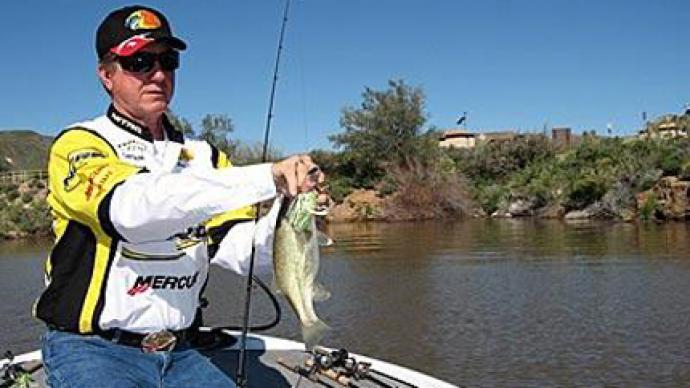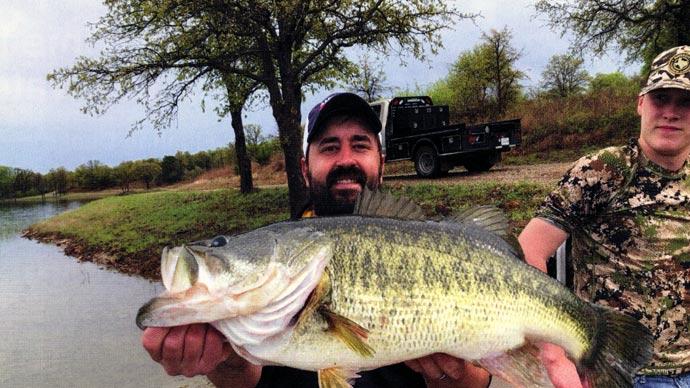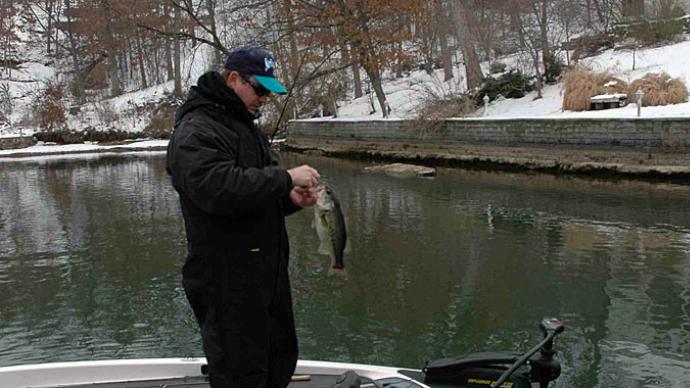
Travis Manson doesn’t let winter stop his bass fishing. A Wisconsin native who fished the Bassmaster Elite Series in 2011 and 2012, he calls southeastern Pennsylvania home now. That makes it an easy tow to Maryland’s Chesapeake Bay. He fishes the tidal fishery, whose popularity with bass anglers is growing year-round. “It can be brutal at times,” he said.
Some days, Manson encounters skim ice in the Bay’s protected portions and iced-over boat ramps, which make launching impossible. But when he can float his bass boat and the water is soft enough for his lures to sink, he finds bass willing to bite, regardless of how far the water temperature has fallen.
Wintertime fishing for tidal-water bass will test your patience, Manson said. But with the right approach and tackle, it’s possible to catch bass under the coldest conditions. And it’s not a situation unique to the Chesapeake. While he’s duplicated his results on the nearby Potomac River, his strategy will prove successful on any tidal water with a bass population. And much of it is easily adaptable to lakes, reservoirs, and rivers where wintertime fishing is available. It all begins with deciding where to fish.
Small spots
Like all tidal waters, the Chesapeake Bay is dynamic, and its constant changes don’t slow during winter. Manson said rain and snow to its north, for example, adds water and sediment to the Bay’s main tributary — the Susquehanna River — turning its water muddy from the 1 to 2 feet of visibility at its clearest. “Cold, muddy water makes [the fishing] tough, but sometimes it can be fantastic,” he said. “Just like everywhere else, [the bass] get lethargic.”
Tidal bass are known for schooling tight in cold water. Chesapeake Bay bass are no different, spending their winters in specific spots. They’re few, so finding one means locating a large school of bass. Manson said simply knowing that spawns enough confidence to keep you casting even if they aren’t biting at the moment.
Manson said the Chesapeake’s wintering spots have three things in common. The water is deep, 8 to 10 feet in this case. They have hard bottoms and cover, such as pilings or rocks, and are close to shallow water. He often finds this combination along ledges, creek channels, and inside marinas.
Manson said that the Bay’s bass spend a relatively short time in these spots. As water temperatures rise and the days get longer in spring, they filter into shallow water and remain there until fall. Once the weather turns cold and the aquatic vegetation dies off, they retreat to the wintering spots.
While their locations may change through the year, the daily tide cycle — two high tides and two low tides — never stop. “It always tells those fish when to feed,” Manson said. Usually, the best fishing happens during the last of the outgoing tide or the first of the incoming tide, when water levels are low, and the current is moving, confining bass to cover. Those types of key feeding windows remain in cold water. “But instead of two or three hours, they bite for an hour,” he said.
Slow lures
Manson shrinks his lure selection during the cold-water season. And while he may dabble with a 3/8- or 1/2-ounce football jig, he’s throwing a blade bait or flat-sided crankbait the rest of the time. Which one he picks up depends on the water temperature.
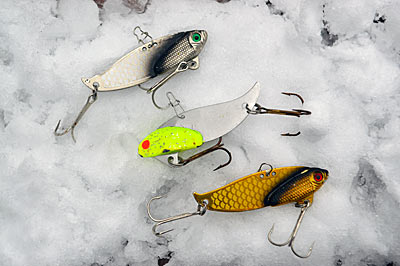
Manson said that the Bay’s water is usually around 40 degrees by mid-November. During the dead of winter, it’ll bottom out in the low 30s before steadily warming as spring nears. When it’s colder than the mid-40s, he uses a blade bait. Anytime it's above that threshold during winter, he fishes small flat-sided crankbaits. Their tight wiggles are proven bass-catchers in cold water.
Manson fishes both lures painfully slow. He likened the retrieve to fishing a Texas- or Carolina-rigged worm. If they don’t hit his blade bait on the initial drop, he starts moving it forward with small hops, only a few inches at a time. It sits motionless in between. He may leave it for 15 or more seconds before it gets heavy, a sure sign that a groggy bass has grown tired of watching it and grabbed it. “It’s hard for guys to take that time,” he said. “It’s a very painstaking way to fish.”
The procedure isn’t much different for the flat-sided crankbaits. Manson makes a long cast, reels it down until it hits bottom, and stops. It’ll stay there because he adds strips of lead tape, such as Storm’s SuspenStrips, to its belly. He adds enough in the coldest water to keep his crankbait suspended just above the bottom, though a slow rise is OK during a warming trend. He alternates slow short pulls and long pauses.
There’s no need to add weight to the 1/2-ounce blade baits, such as Silver Buddies or Heddon Sonars, that Manson slings most of the winter. While he may drop down to a 3/8- or 1/4-ounce model when winds are light, it’s nearly always silver in color. He’ll switch to gold in stained water or under cloudy skies. “Perch can be a good choice, too,” he said.
Whichever color you choose, make sure you have many of them. Raking treble hooks along the bottom means you’re always in danger of snagging a bubbler system, which is used to keep marina slips ice-free, discarded rope, logs, or a host of other sunken items. He said it’s easy to lose ten blade baits in one trip.
Blade baits can be frustrating to fish in other ways, including hooks that tangle with each other and the main line. Taking time to switch treble hooks to double hooks can reduce snags, and Manson said replacing split rings with small loops of braided line can cut down on tangles. But they are difficult to tie and still don’t guarantee you won’t snag and lose your blade bait on the next cast. He said simply dealing with tangles and break off as they happen often is the better use of your fishing time.
Specific gear
Blade baits aren’t only a cold-water option for Manson, who guides bass anglers on several Upstate New York bass factories along with Pennsylvania’s Conowingo Reservoir, the Susquehanna River, and the Chesapeake Bay in between competing in regional bass tournaments. “My favorite way to throw a blade bait is on a baitcaster,” he said. It helps him cast it farther and rip it off the bottom, triggering aggressive bass to strike when the water is warm.
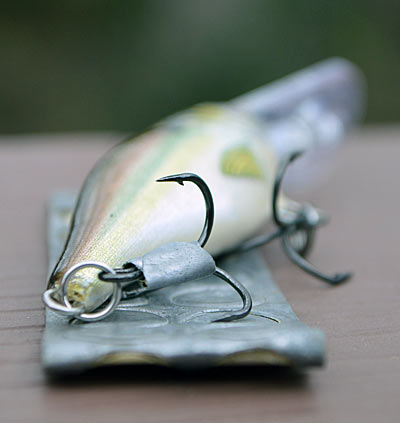
Aggressive approaches rarely work in cold water, when Manson said precision becomes much more critical. He believes that’s easier to achieve with a spinning rod, especially in tight quarters, such as pitching his blade baits perilously close to dock pilings to entice frigid bass that aren’t motivated to move far. He wants it to land no farther than a foot from a piling and drop vertically.
Manson chooses a 7-foot medium-action spinning rod for fishing blade baits in cold water. He spools its reel with 10-pound test braided line, adding a leader of 8-pound test fluorocarbon up to 8 feet long. But that’s not the only option. He said some anglers use straight braid, either 10- or 15-pound test. It has a strength advantage, allowing them to recover some snagged blade baits by pulling enough to straighten their hooks. They can be reshaped with a pair of pliers upon recovery. And in tidal water, which rarely, if ever, runs truly clear, bass are unlikely to see the braid and spook.
If you’re worried more about keeping your blade bait from fouling in your line while casting, Manson said to spool up with fluorocarbon, either 8- or 10-pound test. Stiffer than braid, it helps keep your lure from rolling back into your line. Each angler and blade bait fishes differently, he said, so experiment until you find the setup that works best for you.
Manson ties his flat-sided crankbaits to 8- or 10-pound test fluorocarbon. It fills a baitcasting reel that he mounts on a 7-foot-long fiberglass rod, whose slower parabolic action keeps treble hooks stuck in jumping or surging bass. When he wants to fish his smallest cranks, such as Rapala’s Shad Rap, he’ll grab a spinning outfit with 6- or 8-pound test fluorocarbon line.
The spinning rod makes casting easier, especially on windy days. Manson said casting farther in those conditions is as simple as wrapping one or two lead-tape strips around the shank of the crankbait’s rear hook. But he only does that when he isn’t concerned about it properly suspending — nose pointed slightly down at rest. Weighting the back of the lure causes the opposite, he said.
The slow and repetitive nature of cold-water bass fishing makes other gear helpful. Manson often relies on his shallow-water anchors to hold his boat away from pilings or in perfect position to cast his crankbaits, regardless of the wind’s strength or direction. “It’s good to have a lure retriever, too,” he said. It will free crankbaits and, many times, blade baits.


